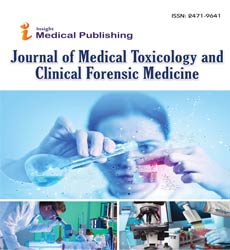Alcohol Intoxication and Sudden Death: Clinical, Legal and Forensic Perspectives
Sarah Khan
Department of Forensic Sciences, King’s College London, London, United Kingdom
Published Date: 2025-02-28DOI10.36648/ 2471-641.11.1.160
Received date: February 03, 2025, Manuscript No. ipjmtcm-25-20809; Editor assigned date: February 05, 2025, Pre QC No. ipjmtcm-25-20809 (PQ); Reviewed date: February 17, 2025, QC No. ipjmtcm-25-20809; Revised date: February 22, 2025, Manuscript No. ipjmtcm-25-20809 (R); Published date: February 28, 2025, DOI: 10.36648/ 2471-641.11.1.160.
Citation: Khan S (2025) Alcohol Intoxication and Sudden Death: Clinical, Legal and Forensic Perspectives. J Med Toxicol Clin Forensic: Vol.11 No. 1:160.
Introduction
Alcohol is one of the most widely consumed psychoactive substances worldwide, with deep-rooted social, cultural, and recreational significance. However, acute intoxication from excessive consumption can have severe health consequences, ranging from impaired judgment to life-threatening physiological disturbances. In certain cases, alcohol intoxication can lead to sudden and unexpected death, posing significant clinical and forensic challenges. These fatalities often raise medico-legal concerns regarding liability, intent, and contributory factors. This article explores alcohol intoxication and sudden death through clinical, legal, and forensic lenses, emphasizing the complexities of diagnosis, investigation, and interpretation. The clinical effects of alcohol intoxication are dose-dependent, with Blood Alcohol Concentration (BAC) serving as the primary indicator of severity. Mild intoxication produces euphoria, disinhibition, and impaired coordination. As BAC rises, symptoms progress to confusion, stupor, hypothermia, hypotension, and respiratory depression. At concentrations exceeding 400 mg/dL, coma and death are likely. Complications such as aspiration pneumonia, arrhythmias, and trauma secondary to impaired reflexes often contribute to mortality [1].
Description
Sudden death associated with alcohol intoxication is multifactorial. Central nervous system depression leading to respiratory arrest is the most common mechanism. Alcohol-induced cardiac arrhythmias, particularly atrial fibrillation and ventricular tachycardia, are well-documented causes. Acute pancreatitis, aspiration of gastric contents and hypoglycemia may also precipitate fatal outcomes. In chronic drinkers, sudden cessation can provoke withdrawal seizures or delirium tremens, which themselves may be fatal. These diverse mechanisms highlight the unpredictable nature of alcohol-related sudden deaths. In many cases, alcohol intoxication is compounded by co-ingestion of other substances such as opioids, benzodiazepines, or stimulants [2].
The synergistic depressant effects of alcohol and opioids markedly increase the risk of respiratory arrest. Similarly, combined alcohol and cocaine use produces cocaethylene, a metabolite with enhanced cardiotoxicity. These interactions complicate both clinical management and forensic interpretation, as determining the primary cause of death may be challenging in poly-substance scenarios. Accurate quantification of BAC in postmortem samples is critical but complicated by postmortem ethanol production due to microbial activity. This phenomenon is especially problematic in decomposed bodies. To minimize errors, vitreous humor and urine are analyzed alongside blood, providing corroborative evidence. Headspace gas chromatography is the gold standard for ethanol analysis due to its precision and specificity. Interpretation requires consideration of postmortem redistribution, individual tolerance, and clinical history [3].
Forensic investigation begins with a thorough scene examination, focusing on evidence of alcohol consumption, such as empty bottles or witness testimonies. Autopsy findings may reveal pulmonary edema, fatty liver, gastritis, or aspiration. However, these are often nonspecific, necessitating toxicological confirmation. Blood, urine, vitreous humor, and other biological fluids are analyzed for ethanol levels. Vitreous humor is particularly valuable in decomposed bodies due to its stability. A meticulous forensic approach is required to distinguish between acute intoxication deaths, trauma-related fatalities, and deaths due to chronic alcoholism [4].
Alcohol-related sudden deaths frequently enter the legal arena. Fatalities in custody, traffic accidents, or workplace environments often involve questions of negligence, liability, or criminal culpability. In cases of custodial deaths, authorities may be held accountable if medical assistance was not promptly provided. Alcohol-related traffic fatalities carry significant legal consequences, with BAC thresholds defining intoxication in most jurisdictions. In occupational settings, sudden death linked to alcohol intoxication raises disputes about employer responsibility and compensation [5].
Conclusion
Alcohol intoxication remains a major global contributor to sudden and unexpected deaths, with profound clinical, forensic, and legal implications. The multifaceted mechanisms of fatality, ranging from respiratory depression to arrhythmias and aspiration, demand careful investigation. Forensic toxicology, coupled with meticulous autopsy and scene examination, is central to determining the role of alcohol in death. Legal consequences span traffic law violations, custodial responsibility, and criminal liability, underscoring the societal impact of alcohol misuse. As analytical techniques advance, the forensic community is increasingly equipped to distinguish genuine intoxication from confounding postmortem changes. A multidisciplinary approach-integrating clinical insight, forensic expertise, and legal frameworks-is essential to addressing the enduring challenge of alcohol-related sudden deaths.
Acknowledgement
None.
Conflict of Interest
None.
References
- Matsumoto KI, Hyodo F, Matsumoto A, Koretsky AP, et al. (2006). High-resolution mapping of tumor redox status by magnetic resonance imaging using nitroxides as redox-sensitive contrast agents. Clin Cancer Res12: 2455-2462.
Google Scholar Cross Ref Indexed at Green Version
- Kuppusamy P, Chzhan M, Vij K, Shteynbuk M, Lefer DJ, et al. (1994). Three-dimensional spectral-spatial EPR imaging of free radicals in the heart: A technique for imaging tissue metabolism and oxygenation. Proc Natl Acad Sci91: 3388-3392.
Google Scholar Cross Ref Indexed at
- Fan L, Sawbridge D, George V, Teng L, Bailey A, et al. (2009). Chronic cocaine-induced cardiac oxidative stress and mitogen-activated protein kinase activation: the role of Nox2 oxidase. J Pharmacol Exp Ther328: 99-106.
Google Scholar Cross Ref Indexed at
- Georgieva E, Ivanova D, Zhelev Z, Bakalova R, Gulubova M, et al. (2017). Mitochondrial dysfunction and redox imbalance as a diagnostic marker of “free radical diseases”. Anticancer Res37: 5373-5381.
- Liaudet L, Calderari B, Pacher P. (2014). Pathophysiological mechanisms of catecholamine and cocaine-mediated cardiotoxicity. Heart Fail Rev 19: 815-824.

Open Access Journals
- Aquaculture & Veterinary Science
- Chemistry & Chemical Sciences
- Clinical Sciences
- Engineering
- General Science
- Genetics & Molecular Biology
- Health Care & Nursing
- Immunology & Microbiology
- Materials Science
- Mathematics & Physics
- Medical Sciences
- Neurology & Psychiatry
- Oncology & Cancer Science
- Pharmaceutical Sciences
